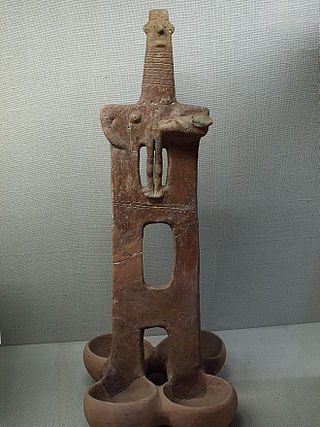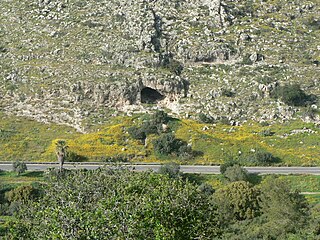Related Research Articles

Mehrgarh is a Neolithic archaeological site situated on the Kacchi Plain of Balochistan in Pakistan. It is located near the Bolan Pass, to the west of the Indus River and between the modern-day Pakistani cities of Quetta, Kalat and Sibi. The site was discovered in 1974 by the French Archaeological Mission led by the French archaeologists Jean-François Jarrige and his wife, Catherine Jarrige. Mehrgarh was excavated continuously between 1974 and 1986, and again from 1997 to 2000. Archaeological material has been found in six mounds, and about 32,000 artifacts have been collected from the site. The earliest settlement at Mehrgarh—located in the northeast corner of the 495-acre (2.00 km2) site—was a small farming village dated between 7000 BCE and 5500 BCE.

The Neolithic period, or New Stone Age, is an Old World archaeological period and the final division of the Stone Age. It saw the Neolithic Revolution, a wide-ranging set of developments that appear to have arisen independently in several parts of the world. This "Neolithic package" included the introduction of farming, domestication of animals, and change from a hunter-gatherer lifestyle to one of settlement.

The 8th millennium BC spanned the years 8000 BC to 7001 BC. In chronological terms, it is the second full millennium of the current Holocene epoch and is entirely within the Pre-Pottery Neolithic B (PPNB) phase of the Early Neolithic. It is impossible to precisely date events that happened around the time of this millennium and all dates mentioned here are estimates mostly based on geological and anthropological analysis, or by radiometric dating.
Shillourokambos is a Pre-Pottery Neolithic B (PPNB) site near Parekklisia, 6 km east of Limassol in southern Cyprus. It is located on a low plateau. Excavations began in 1992. The settlement has four phases and was occupied from the end of the 9th millennium to the second half of the 8th millennium.

Pre-Pottery Neolithic A (PPNA) denotes the first stage of the Pre-Pottery Neolithic, in early Levantine and Anatolian Neolithic culture, dating to c. 12,000 – c. 10,800 years ago, that is, 10,000–8800 BCE. Archaeological remains are located in the Levantine and Upper Mesopotamian region of the Fertile Crescent.

Pre-Pottery Neolithic B (PPNB) is part of the Pre-Pottery Neolithic, a Neolithic culture centered in upper Mesopotamia and the Levant, dating to c. 10,800 – c. 8,500 years ago, that is, 8800–6500 BC. It was typed by British archaeologist Kathleen Kenyon during her archaeological excavations at Jericho in the West Bank.
Sesklo is a village in Greece that is located near Volos, a city located within the municipality of Aisonia. The municipality is located within the regional unit of Magnesia that is located within the administrative region of Thessaly. During the prehistory of Southeastern Europe, Sesklo was a significant settlement of Neolithic Greece, before the advent of the Bronze Age and millennia before the Mycenaean period.

The Prehistoric Period is the oldest part of Cypriot history. This article covers the period 10,000 to 800 BC and ends immediately before the documented history of Cyprus begins.

The Dawenkou culture was a Chinese Neolithic culture primarily located in the eastern province of Shandong, but also appearing in Anhui, Henan and Jiangsu. The culture existed from 4300 to 2600 BC, and co-existed with the Yangshao culture. Turquoise, jade and ivory artefacts are commonly found at Dawenkou sites. The earliest examples of alligator drums appear at Dawenkou sites. Neolithic signs, perhaps related to subsequent scripts, such as those of the Shang dynasty, have been found on Dawenkou pottery.

ʿAin Ghazal is a Neolithic archaeological site located in metropolitan Amman, Jordan, about 2 km north-west of Amman Civil Airport. The site is remarkable for being the place where the ʿAin Ghazal statues were found, which are among the oldest large-sized statues ever discovered.

In the archaeology of Southwest Asia, the Late Neolithic, also known as the Ceramic Neolithic or Pottery Neolithic, is the final part of the Neolithic period, following on from the Pre-Pottery Neolithic and preceding the Chalcolithic. It is sometimes further divided into Pottery Neolithic A (PNA) and Pottery Neolithic B (PNB) phases.

The Pre-Pottery Neolithic (PPN) represents the early Neolithic in the Levantine and upper Mesopotamian region of the Fertile Crescent, dating to c. 12,000 – c. 8,500 years ago,. It succeeds the Natufian culture of the Epipalaeolithic Near East, as the domestication of plants and animals was in its formative stages, having possibly been induced by the Younger Dryas.

Tenta, also referred to as Kalavasos-Tenta or Tenda, is an Aceramic Neolithic settlement located in modern Kalavasos near the southern coast of Cyprus. The settlement is approximately 38 kilometres southwest of Larnaca and approximately 45 kilometres south of Nicosia. Tenta occupies a small natural hill on the west side of the Vasilikos valley, close to the Nicosia–Limassol highway.

The Philia culture existed on the island of Cyprus at the start of the Early Bronze Age between 2450 and 2200 BC. It derives its name from a location in Morphou, Cyprus.

Tell Qaramel is a tell, or archaeological mound, located in the north of present-day Syria, 25 km north of Aleppo and about 65 km south of the Taurus mountains, adjacent to the river Quweiq that flows to Aleppo.

Nahal Oren is an archaeological site on the northern bank of the wadi of Nahal Oren (Hebrew)/Wadi Fallah (Arabic) on Mount Carmel, 10 km (6.2 mi) south of Haifa, Israel. The site comprises a cave and the small terrace in front of it, which steeply descends towards the wadi floor. The site was first excavated in 1941. Kebaran, Natufian (Epipaleolithic) and Pre-Pottery Neolithic A and B industries were found.
Tell Aswad, Su-uk-su or Shuksa, is a large prehistoric, neolithic tell, about 5 hectares (540,000 sq ft) in size, located around 48 kilometres (30 mi) from Damascus in Syria, on a tributary of the Barada River at the eastern end of the village of Jdeidet el Khass.

Beidha, also sometimes Bayda, is a major Neolithic archaeological site a few kilometres north of Petra near Siq al-Barid in Jordan. It is included in Petra's inscription as a UNESCO World Heritage Site.
Tell Halula is a large, prehistoric, neolithic tell, about 8 hectares (860,000 sq ft) in size, located around 105 kilometres (65 mi) east of Aleppo and 25 kilometres (16 mi) northwest of Manbij in the Raqqa Governorate of Syria.
Kharaysin is a Pre-Pottery Neolithic site (PPN) located in the village of Quneya, at the Zarqa River valley, Jordan. This site was discovered in 1984 by Hanbury-Tenison and colleagues during the Jerash Region Survey. The site was allocated to the Pre-Pottery Neolithic B because of the analysis of archaeological artefacts recovered on the surface.
References
- ↑ "Archaeology Wordsmith". www.archaeologywordsmith.com. Retrieved 2016-03-07.
- ↑ "Archaeology Wordsmith". www.archaeologywordsmith.com. Retrieved 2016-03-07.
- ↑ Banning, Edward (2002-01-01). "Aceramic Neolithic". In Peregrine, Peter N.; Ember, Melvin (eds.). Encyclopedia of Prehistory. Springer US. pp. 1–20. doi:10.1007/978-1-4615-0023-0_1. ISBN 9781468471359.
- ↑ "Untitled Document". www.brynmawr.edu. Archived from the original on 2013-10-20. Retrieved 2016-03-07.
- ↑ "Untitled Document". www.brynmawr.edu. Archived from the original on 2016-04-05. Retrieved 2016-03-07.
- ↑ Stone-Miller, Rebecca, Art of the Andes, pp. 7, 18-23, 2002 (2nd edn), Thames & Hudson, World of Art series, ISBN 0500203636